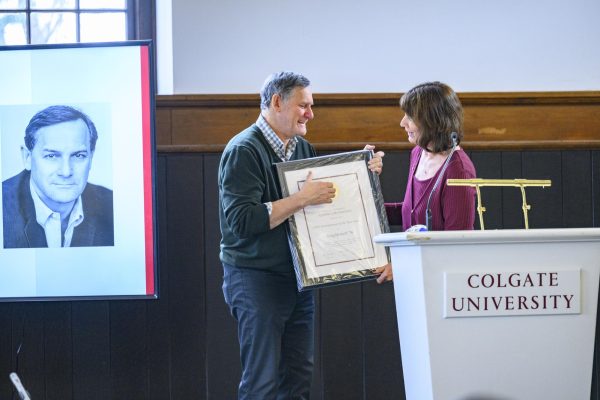The Core of a Colgate Education
1928 was a year in which one of Colgate’s foremost traditions was founded: the Core Curriculum (Core). Since then, the Core has experienced continuous change and alteration. Now, 77 years later, the Core is still evolving, faces the possibility of even more change in coming years.
The most recent changes in the curriculum have come in the form of student involvement and internal and external review. The Core has also been the subject of much discussion for faculty, students and alumni alike.
In 1999, the Student Government Association (SGA) raised concerns that many Colgate students could graduate without having confronted issues pertaining to social justice. Efforts to correct this problem led to the creation of the Student Curriculum Initiative (SCI). Members of the initiative worked with the Academic Affairs Board (AAB) and Curriculum Committee to examine the Core classes 151 and 152. The SCI published a newsletter detailing their cause.
Then-President of SGA David Mills wrote in a newsletter, “Because of the strong support shown…the Curriculum Committee of the AAB has assigned SCI a high priority. We believe that SCI is the first student-directed initiative of this type since 1969, when a similar initiative led to the creation of the [ALANA] Cultural Center.”
While not quite on par with ALANA, the students managed to create the “Isms of Society” physical education course through their efforts.
Five years later, the merits of the Core were once again examined — this time internally by staff and faculty, as well externally by several outside groups.
The internal review process was started in preparation for possible changes to the Core, when it will be revised in 2007. Many avenues were taken for assessment.
Director of University Studies and Professor of Romance Languages and Literatures Lourdes Rojas-Paiewonsky explained some ways that faculty compile information about the Core.
“We have four components of the Core,” she said. “Faculty gather according to those components, and each component has what you call a university professor [UP], and we gather weekly. In other words, there are different gatherings of faculty. First, according to their components – these are called staff gatherings. Core 151 has a particular time and date when they gather regularly to discuss issues of methodology, curriculum [and] programming, the same thing for 152, Core Cultures, as well as Scientific Perspectives. Then, the UP of each component meets with me every week and they bring to the table what they have learned in their staff meetings.”
These meetings and other sources of information create a dialogue that addresses some concerns about the Core. Rojas provided a few examples.
“Some professors are concerned with looking at ‘the other’ in an exotic way, or ‘exotic-ising the other,’ as they call it,” she said about the Core Cultures. “Others see that there is no way to teach about these cultures unless we have a course on Peru, Core Colombia. Those are conversations that are taking place within Core Cultures.”
Beyond faculty meetings, Rojas took the Core question to the students in 2003. A group of randomly selected students were called in for an interview in which they were asked about the Core. The interview provided much insight into the students’ perspectives and from it about 20 pages of transcript was compiled.
Rojas helped conduct the interviews.
“The sense that I got from that interview is that many students didn’t see how wonderful and important it was for their overall education when they were taking it,” she said, “and they resented being forced to take Core. Then, when they had taken it … they say, well, it was wonderful.”
The interview was not performed solely for the benefit of the internal evaluation process. It was also made available for outside reviewers to analyze. In 2004, a group of four scholars came to Colgate to evaluate the Core objectively. Lynn Bolles from the University of Maryland, James Redfield from the University of Chicago, Kimmo Rosenthal of Union College, and Paula Sanders of Rice University made up the group of investigators.
They produced the “Colgate University Liberal Arts Core Curriculum External Review Report” after examining the aforementioned interview, various set forms and Colgate’s internal review. They also talked personally with staff, faculty and students. The report suggested many changes for the Core curriculum.
On Colgate’s writing program, the report reads, “The Core does orient students to Colgate, initiate them into higher education and suggest to them the importance of breadth of education. It does less well in the teaching of basic skills. The writing component of 151/2 seems…under-supported; a bare prescription of 15 pages a term is well short of anything one could call a writing program.”
It also pointed out concerns about how Core is perceived among students and faculty.
“We find it puzzling that most departments seem to think that departmental programs must come first,” the report said, “while the Core is to be staffed with a kind of surplus of spare resources, and that some students get the message that senior faculty resent assignment to the Core.”
The reviewers examined each component of the Core separately and revealed issues regarding each.
“Students who were not interested in the merits of [Core Cultures] or in learning what this configuration of courses meant in the educational plan, were difficult to engage,” the report read. “Faculty expressed concerns over the presence of students in [Core Cultures] courses who struck them as being National Geographic voyeurs looking for the exotic, [and as being] xenophobic or benign racists.”
While many of the proposed changes require only slight modifications, the external reviewers did suggest some surprisingly large changes, like “abandoning the distribution requirements as currently constituted.”
At the end of the day, the final analysis was overwhelming support for the Core Curriculum, and the reviewers voiced much praise for the program. This contrasts, however, the findings of another external body that found Colgate’s Core largely insufficient-the American Council of Trustees and Alumni (ACTA).
ACTA also reviewed Colgate’s curriculum; it used a general grading system based on the number of required courses in given departments. ACTA gave Colgate an “F.” Other schools that failed ACTA’s test were Berkeley, Smith, Vassar and Mount Holyoke.
Colgate’s “F” is often cited as evidence for the school’s decaying academic standards, but University President Rebecca Chopp dismisses ACTA’s findings.
“At the end of the day, I feel like they didn’t really look at the syllabi for the courses,” she said. “They didn’t come and talk to the students; they didn’t come and talk with the faculty; they didn’t look at the broader distribution requirements. The AACU – the American Association of Colleges and Universities – ranked our CORE very highly. They did very careful analysis, and they listed us as a model school…”
Still, criticism of the Core does exist for students and alumni. Many students charge that the Core is too easy and fails to promote basic learning skills. Some alumni agree. Yet, the general consensus seems to be that the Core is useful, despite its faults.
“When I talk to graduating seniors and alums and ask them what parts of their education had a lot of impact, the Core comes up very frequently in those conversations,” Dean of the Faculty and Provost Lyle Roelofs said. “So, my sense is, that it is a challenging and important part of a Colgate student’s education – especially the fact that it is something that all Colgate students share.”
Roelofs also reiterated the fact that Colgate’s Core truly is one of its most unique assets.
“My sense of the Core is that it is unusual, almost unique, among colleges in providing for students a shared educational experience-especially the 151/152 part,” he said. “All the students at Colgate have read some of the same works and approached them in an academic and scholarly way. Although that is a traditional feature of college education is the US, Colgate is one of the very few institutions to have maintained that and I think it is actually a very important part the Colgate curriculum.”






